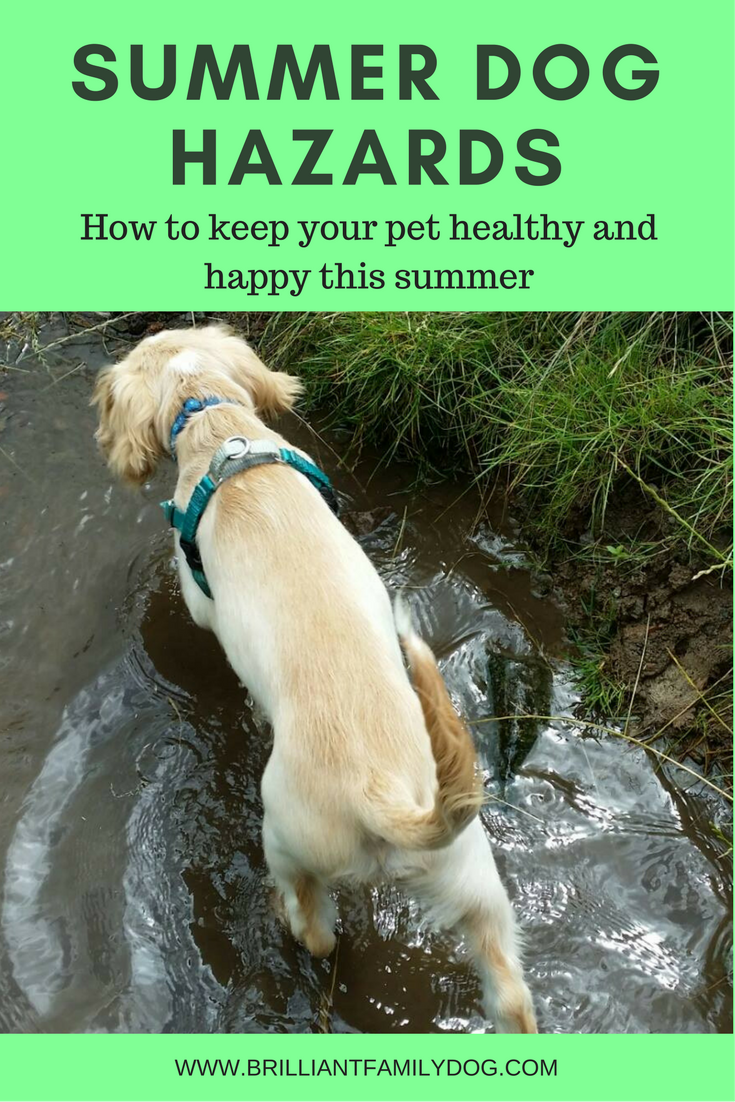We’re having quite a mixed bag of weather in the UK this summer! From the hottest July day ever to cool summer soakings. So it’s worth taking a look at how these hazards can affect your dog. We all know that cars can turn into killing ovens within minutes on a sunny day, whether the windows are open or not.
But there are other times dogs can get dangerously overheated:
Dogs can only lose heat through their pads and their tongues. If your dog has been racing about in warm or close weather, you can tell from the style of his panting just how hot he is.
If his tongue becomes very wide in a big spoon shape it means his body is doing its best to get rid of excess heat. If he’s breathing really fast and his sides are heaving, long after exercise, then you need to cool him and monitor his movements.
Swimming is a great way for a dog to keep cool in warm weather. The evaporation draws plenty of heat off the body. If there’s no water to swim in (paddling pools are great fun), you can wet his head to help cool him, and I’m a great fan of the wet t-shirt!
A cool stream is the perfect place for a hot puppy
Soak the shirt, wring it out a bit, then put it on your dog, tying the excess in a knot on his back near his tail to keep it from flapping around his hind legs. You’ll need to resoak it regularly depending on how sunny it is.
Small dogs can fit a child’s t-shirt - or, of course, you can buy custom dog shirts. Some are made of fabric that retain the moisture longer and are marketed as cooling shirts.
And a tip from Ellie the Briard in Italy - fill a plastic water bottle with cold water, screw the cap on tight, and see how long it takes your dog to turn it into a fountain!
Puppies find it harder to regulate their body heat, so they can get too cold or too hot quite quickly. If they get wet and the weather is cool, you need to dry them carefully. They don’t have an undercoat - their puppy fluff will become their undercoat when the coarser guard hairs grow - so they can chill fast.
Dogs with non-pigmented skin, usually found like little pink maps above the nose, can suffer from sunburn, so suncream suitable for children can be used. It has to be safe if swallowed.
Some white dogs (and cats) have the same problem round their eyes and on the edges of the ears - prime areas for skin cancers to develop - so they need sun protection through the whole summer.
From midsummer, grass seeds prove a nuisance. Their sharp points can penetrate skin and work their way in. It takes me a while to go over my crew after each walk to remove them all. That alone is a good reason for keeping paw hair trimmed and feet neat, so the seeds can’t get into the foot and travel up inside the leg.
Sunbathing snakes are a hazard to watch for. Urgent veterinary attention will be needed for a bite - usually to the face of the curious dog.
Bee and wasp stings can usually be dealt with at home, if not multiple. Remember B for Baking Soda (for Bee stings) and W for … Vinegar (for Wasp stings). Bit of a stretch, that, but it helps me remember! One sting is acid and the other is alkali, so you need to neutralise them.
More summer country walks will mean more ticks climbing on board. You can get a handy gadget to remove them. It may take a few days before they’re clearly visible. They look like a small baked bean sticking out of the hair.
This is just a brief rundown of summer hazards. It’s worth having a look in Google, especially for your area, so you are forearmed.
And to help keep your dog where you want him, have a look at this free e-course about everyday dog problems.



